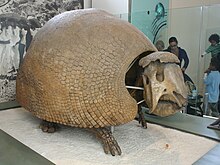Panochthus
|
Panochthus |
|
|---|---|

|
|
| P. frenzelianus | |

|
|
| Skeleton and shell of Panochthus tuberculatus | |
| Scientific classification | |
| Domain: | Eukaryota |
| Kingdom: | Animalia |
| Phylum: | Chordata |
| Class: | Mammalia |
| Order: | Cingulata |
| Family: | Chlamyphoridae |
| Subfamily: | †Glyptodontinae |
| Genus: |
†Panochthus Burmeister, 1866 |
| Type species | |
|
†Panochthus tuberculatus
Owen, 1845
|
|
| Species | |

|
|
| Inferred range of the genus Panochthus based on known localities | |
| Synonyms | |
|
Synonyms of P. tuberculatus
Synonyms of P. greslebini
|
|
Panochthus is an extinct genus of glyptodont, which lived in the Gran Chaco-Pampean region of Argentina (Lujan, Yupoí and Agua Blanca Formations), Brazil (Jandaíra Formation), Bolivia (Tarija and Ñuapua Formations), Paraguay and Uruguay (Sopas and Dolores Formations) during the Pleistocene epoch.
It could reach 3 metres (9.8 ft) in length and a weight up to 1,500 kilograms (3,300 lb) the upper skull and the body were protected by hemispherical armor composed of hundreds of rounded scales. The tail, short and wedge-shaped, consisted of small bony bands with small spikes used for defense. Preserved tracheal rings are known from one specimen.
Gallery
-
Panochthus vogti skull
-
 1878 restoration of P. tuberculatus
1878 restoration of P. tuberculatus

